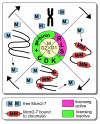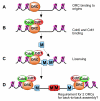Preventing re-replication of chromosomal DNA
- PMID: 15928711
- PMCID: PMC2688777
- DOI: 10.1038/nrm1663
Preventing re-replication of chromosomal DNA
Abstract
To ensure its duplication, chromosomal DNA must be precisely duplicated in each cell cycle, with no sections left unreplicated, and no sections replicated more than once. Eukaryotic cells achieve this by dividing replication into two non-overlapping phases. During late mitosis and G1, replication origins are 'licensed' for replication by loading the minichromosome maintenance (Mcm) 2-7 proteins to form a pre-replicative complex. Mcm2-7 proteins are then essential for initiating and elongating replication forks during S phase. Recent data have provided biochemical and structural insight into the process of replication licensing and the mechanisms that regulate it during the cell cycle.
Figures







References
-
- Rao PN, Johnson RT. Mammalian cell fusion: studies on the regulation of DNA synthesis and mitosis. Nature. 1970;225:159–164. - PubMed
-
- Blow JJ, Laskey RA. A role for the nuclear envelope in controlling DNA replication within the cell cycle. Nature. 1988;332:546–548. - PubMed
-
- Nishitani H, Lygerou Z. DNA replication licensing. Frontiers in Bioscience. 2004;9:2115–2132. - PubMed
-
- Ishimi Y. A DNA helicase activity is associated with an MCM4, -6, and -7 protein complex. J. Biol. Chem. 1997;272:24508–24513. - PubMed
Publication types
MeSH terms
Substances
Grants and funding
LinkOut - more resources
Full Text Sources
Other Literature Sources
Molecular Biology Databases
Miscellaneous

